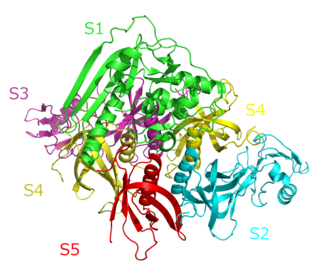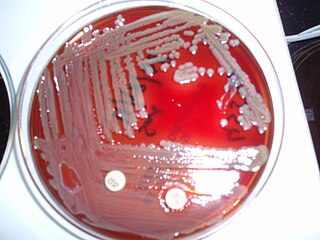Bloodstream infections (BSIs), which include bacteremias when the infections are bacterial and fungemias when the infections are fungal, are infections present in the blood. Blood is normally a sterile environment, so the detection of microbes in the blood is always abnormal. A bloodstream infection is different from sepsis, which is the host response to bacteria.

Bordetella is a genus of small, gram-negative coccobacilli of the phylum Proteobacteria. Bordetella species, with the exception of B. petrii, are obligate aerobes, as well as highly fastidious, or difficult to culture. All species can infect humans. The first three species to be described ; are sometimes referred to as the 'classical species'. Two of these are also motile.

Pertussis toxin (PT) is a protein-based AB5-type exotoxin produced by the bacterium Bordetella pertussis, which causes whooping cough. PT is involved in the colonization of the respiratory tract and the establishment of infection. Research suggests PT may have a therapeutic role in treating a number of common human ailments, including hypertension, viral infection, and autoimmunity.
Bartonellosis is an infectious disease produced by bacteria of the genus Bartonella. Bartonella species cause diseases such as Carrión's disease, trench fever, cat-scratch disease, bacillary angiomatosis, peliosis hepatis, chronic bacteremia, endocarditis, chronic lymphadenopathy, and neurological disorders.

Bordetella pertussis is a Gram-negative, aerobic, pathogenic, encapsulated coccobacillus of the genus Bordetella, and the causative agent of pertussis or whooping cough. Like B. bronchiseptica, B. pertussis is motile and expresses a flagellum-like structure. Its virulence factors include pertussis toxin, adenylate cyclase toxin, filamentous hæmagglutinin, pertactin, fimbria, and tracheal cytotoxin.

A subclinical infection — sometimes called a preinfection or inapparent infection — is an infection that, being subclinical, is nearly or completely asymptomatic. A subclinically infected person is thus a paucisymptomatic or asymptomatic carrier of a microbe, intestinal parasite, or virus that usually is a pathogen causing illness, at least in some individuals. Many pathogens spread by being silently carried in this way by some of their host population. Such infections occur both in humans and animals.

Elizabethkingia meningoseptica is a Gram-negative, rod-shaped bacterium widely distributed in nature. It may be normally present in fish and frogs; it may be isolated from chronic infectious states, as in the sputum of cystic fibrosis patients. In 1959, American bacteriologist Elizabeth O. King was studying unclassified bacteria associated with pediatric meningitis at the Centers for Disease Control and Prevention in Atlanta, when she isolated an organism that she named Flavobacterium meningosepticum. In 1994, it was reclassified in the genus Chryseobacterium and renamed Chryseobacterium meningosepticum(chryseos = "golden" in Greek, so Chryseobacterium means a golden/yellow rod similar to Flavobacterium). In 2005, a 16S rRNA phylogenetic tree of Chryseobacteria showed that C. meningosepticum along with C. miricola were close to each other but outside the tree of the rest of the Chryseobacteria and were then placed in a new genus Elizabethkingia named after the original discoverer of F. meningosepticum.

Bordetella parapertussis is a small Gram-negative bacterium of the genus Bordetella that is adapted to colonise the mammalian respiratory tract. Pertussis caused by B. parapertussis manifests with similar symptoms to B. pertussis-derived disease, but in general tends to be less severe. Immunity derived from B. pertussis does not protect against infection by B. parapertussis, however, because the O-antigen is found only on B. parapertussis. This antigen protects B. parapertussis against antibodies specific to B. pertussis, so the bacteria are free to colonize the host's lungs without being subject to attack by previous antibodies. These findings suggest B. parapertussis evolved in a host population that had already developed immunity to B. pertussis, where being able to evade B. pertussis immunity was an advantage.
Bartonella rochalimae is a recently discovered strain of Gram-negative bacteria in the genus Bartonella, isolated by researchers at the University of California, San Francisco (UCSF), Massachusetts General Hospital, and the United States Centers for Disease Control and Prevention. The bacterium is a close relative of Bartonella quintana, the microbe which caused trench fever in thousands of soldiers during World War I. Named after Brazilian scientist Henrique da Rocha Lima, B. rochalimae is also closely related to Bartonella henselae, a bacterium identified in the mid-1990s during the AIDS epidemic in San Francisco as the cause of cat scratch fever, which still infects more than 24,000 people in the United States each year.
Bartonella quintana, originally known as Rochalimaea quintana, and "Rickettsia quintana", is a bacterium transmitted by the human body louse that causes trench fever. This bacterial species caused outbreaks of trench fever affecting 1 million soldiers in Europe during World War I.
Clostridium innocuum is an anaerobic, non-motile, gram-positive bacterium that reproduces by sporulation. While there are over 130 species of Clostridium, C. innocuum is the third most commonly isolated. Although it is not normally considered an aggressive human pathogen, it has been isolated in some disease processes. C. innocuum and other Clostridium line the oropharynx and gastrointestinal tract, and are considered normal gut flora.

Clostridium tertium is an anaerobic, motile, gram-positive bacterium. Although it can be considered an uncommon pathogen in humans, there has been substantial evidence of septic episodes in human beings. C. tertium is easily decolorized in Gram-stained smears and can be mistaken for a Gram-negative organism. However, C.tertium does not grow on selective media for Gram-negative organisms.

Lancefield grouping is a system of classification that classifies catalase-negative Gram-positive cocci based on the carbohydrate composition of bacterial antigens found on their cell walls. The system, created by Rebecca Lancefield, was historically used to organize the various members of the family Streptococcaceae, which includes the genera Lactococcus and Streptococcus, but now is largely superfluous due to explosive growth in the number of streptococcal species identified since the 1970s. However, it has retained some clinical usefulness even after the taxonomic changes, and as of 2018, Lancefield designations are still often used to communicate medical microbiological test results in the United States.

Achromobacter xylosoxidans is a Gram-negative, aerobic, oxidase and catalase-positive, motile bacterium with peritrichous flagella, from the genus Achromobacter. It is generally found in wet environments. Achromobacter xylosoxidans can cause infections such as bacteremia, especially in patients with cystic fibrosis. In 2013, the complete genome of an A. xylosoxidans strain from a patient with cystic fibrosis was sequenced.
Bartonella alsatica is a proteobacterium. Like other Bartonella species, it can cause disease in animals. It is small, aerobic, oxidase-negative, and Gram-negative. Its rod-like cells were localized within wild rabbit erythrocytes when first described. The type strain is IBS 382T. It is associated with cases of lymphadenitis and endocarditis.
Rickettsia heilongjiangensis is a species of gram negative Alphaproteobacteria, within the spotted fever group, being carried by ticks. It is pathogenic.
Inquilinus limosus is a bacterium first isolated from cystic fibrosis patients' lungs, and is rarely observed elsewhere, prompting extensive research into its biology.
Citrobacter farmeri is a Gram-negative species of bacteria.
Bartonella clarridgeiae is a Gram-negative bacteria from the genus Bartonella which was first isolated in the United States. Bartonella clarridgeiae is a zoonotic pathogen which can cause cat scratch disease.
Catabacter hongkongensis is a species of clinically relevant gram-positive coccobacilli, first isolated from patients in Hong Kong and Canada in 2006. Although the species remains relatively rare, it has a high mortality rate of up to 50%. Catabacter is thought to be broadly distributed globally, as it has been isolated from patient blood cultures around the world including Hong Kong, South Korea, New Zealand, Canada, Sweden, France and Italy. Less than 15 cases of C. hongkongensis have been observed worldwide.








